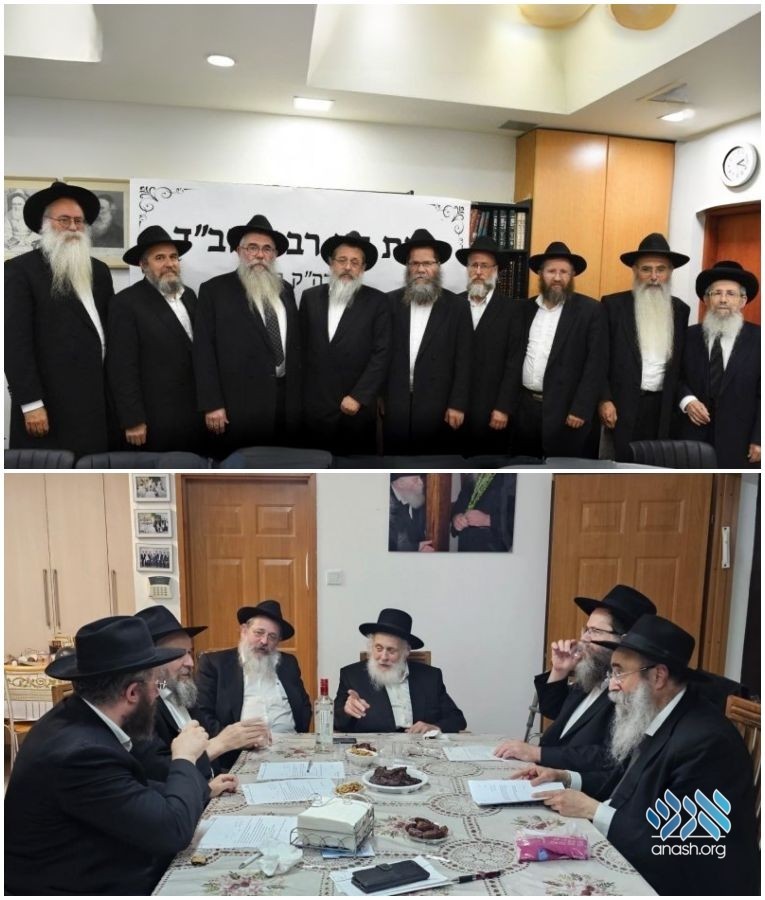ט׳ אב ה׳תשפ״ד | August 13, 2024
Newly Appointed Rabbonim Talk Their Vision for Anash
Following the recent expansion of Beis Din Rabbonei Chabad in Eretz Yisroel, the nine new rabbonim sat down to share their vision for Anash and the role of the rabbonim in our times.

Following the recent expansion of Beis Din Rabbonei Chabad in Eretz Yisroel, the nine new rabbonim sat down to share their vision for Anash and the role of the rabbonim in our times.
By Anash.org staff
In recent months, Beis Din Rabbanei Chabad of Eretz Hakodesh, the central Rabbinic organization established by the Rebbe to lead all Chabad matters in the Eretz Yisroel, announced its expansion with a total of nine new members. The new members are experienced rabbonim who are in positions in cities across Eretz Yisroel and have been involved with guiding Anash for decades.
In a round table interview published in this past week’s Kfar Chabad Magazine, the rabbonim shared their vision for Anash and what they see as the role of rabbonim today.
Rabbi Meir Ashkenazi, the Rov of Kfar Chabad, shared: “We are facing a challenging period, often encountering economic questions that might impact our identity. Issues like the draft of yeshiva bochurim in Eretz Yisroel, secular studies, and the pervasive use of mobile devices present many nisyonos. The challenges are significant because the Chabad community isn’t secluded but goes out to spread Yiddishkeit. Beis Din Rabbonei Chabad needs to lead in these matters according to the Rebbe’s directives.”
Rabbi Mordechai Bistritzky, Rov of Anash in Tzfas, emphasized in his interview: “It is crucial to establish a relationship between the Beis Din and the rabbis of all Anash communities, visiting the communities and thinking of ways to support them. In chinuch, there are many issues, such as students not being accepted into schools for various reasons, strengthening kosher phones and computer filters, and more. Encouraging Torah learning in Anash communities is also very important.”
Rabbi Schneur Zalman Yaroslavsky, Rov of Anash in Elad, stated: “The Rebbe wanted a Chabad body to handle Chabad issues internally, granting full authority and power to the Beis Din, hoping it would lead the community. Today, more than ever, Anash is looking for leadership. With an expanded Beis Din, we will enhance the community fabric of Anash. If we act correctly, we will see the Rebbe’s brachos with Hashem’s help.”
Rabbi Yaakov Mendelsohn, Rav of Anash in Arad, mentioned: “Anash are looking for leadership. People, especially Chassidim, do not like a lack of leadership and anarchy. I hope that Chabad rabbonim within the Beis Din will be assertive and actively initiate matters that will uplift Anash and set a clear path. There are many areas to address, including education for boys and girls, the current issue of the army, and more. To advance these matters, we must stand firm and think constantly about what is best for Anash and the community.”
Rabbi Yosef Yitzchak Wolosow, Rav of Ramat Yishai, said: “The Beis Din members, both veterans and newcomers, bear a heavy responsibility to tread a path that ‘carries opposites’: on one hand, we do not compromise even a bit on matters of halacha and the Rebbe’s hora’os, and on the other hand, we must act in a respectful and loving manner to connect the community to Torah and the Rebbe.”
Rabbi Chaim Kizhner, Rav of Anash in Emmanuel, explained: “The Beis Din’s role mainly divides into two areas: promoting limud Torah and guiding the Chabad communal activities in Eretz Yisroel. The Rebbe demanded multiple times that the Beis Din be involved in public matters within Anash. Beyond the revolution in supervising and guiding Chabad mikvaoss, there are other areas where the Beis Din must act for the benefit of Anash, such as the STaM market, which has many breaches that the Beis Din can address.”
Rabbi Yeshayahu Hertzel, Rav of Nof HaGalil, shared: “The main role of a rov, when judging a person, is to judge them favorably. When judgments are made in this manner, it brings goodness and peace to the world. The Beis Din has expanded with representatives from all regions of the country, and I feel obligated to do everything possible to represent the region from which I come and represent. The Beis Din operates with the Rebbe’s kochos, and we certainly need more divine assistance for this.”
Rabbi Chaim Shlomo Diskin, Rov of Kiryat Ata, noted: “There is an opportunity, with the expanded Beis Din representing various styles and communities within Anash, to make more people feel part of and at home under the Beis Din’s umbrella, as per the Rebbe’s desire. The more members there are in the Beis Din, the more unity we can achieve among the people. As rabbis, we must encompass the entire community and reach everyone.”
Rabbi Yaakov Shwica, a Rosh Yeshiva in the Kfar Chabad Yeshiva, shared: “The Anash community has grown significantly, increasing the need for an expanded Beis Din. It is written that when a Beis Din gives a psak on a specific judgment, even if there are differing opinions within the Beis Din, the ruling is considered the decision of all members together, as we follow the majority. This expansion is a major development for the community, as a larger Beis Din means rulings accepted by a greater number of rabbonim.”

BH. May all the Rabbonim be blessed and given all strength and all they need to fulfil their tasks.